Excavation Contractors Langport
Top Excavation Services in Langport
Get multiple Digging Contractors quotes for your project today! Compare profiles, reviews, accreditations, portfolio, etc... and choose the best offer.

K Mulholland & son ltd
51 reviewsChard, GBAbout Wales Building Network Your building project deserves the best … Highest standard project management and workmanship Carefully matched to existing building style and materials Compliant with building regulations and codes of practice. Members of the Wales Building Network can undertake any construction project in Wales, and nothing is too small or too complicated. Be it renovations, woodwork, bathroom and kitchen fitting, extensions and conversions, plumbing or joinery, our approved panel of building contractors are here to build your perfect home using the latest designs, highest quality materials and all of our expertise! Our experienced builders will complete each stage of your domestic or commercial project, from the conception of the plumbing and heating system to the decorations to complicated electrical wiring. If you are looking for local builders in Wales, get in touch today. Our members are competitively priced with an excellent track record of customer satisfaction.
- Services
- Why Us?
- Gallery
Get Quote
Stredder Construction
51 reviewsChard, GBStredder Group: Your Trusted Partner for Strip Out, Demolition, Construction, and Maintenance in Merseyside and the North West Since 2007, Stredder Group has been a leading provider of comprehensive construction and strip out services across Merseyside and the North West. We are renowned for our expertise in strip out projects, delivering exceptional results with a commitment to safety, efficiency, and customer satisfaction. Our team of highly skilled professionals is dedicated to exceeding expectations on every project. We understand the importance of meticulous planning, efficient execution, and clear communication to ensure a smooth and successful outcome. Whether you require a complete strip out, demolition, new build, refurbishment, or maintenance services, Stredder Group is your reliable partner. We are proud of our strong track record and the trust our clients place in us. Our commitment to quality, safety, and customer satisfaction is reflected in every project we undertake. Contact us today to discuss your project requirements and experience the Stredder Group difference.
- Services
- Why Us?
- Gallery
Get Quote
XTPlant Specialist Landscaping LTD
Unit 1, The Business Centre, Severalls Lane, Colchester, CO7 7QJ, GBAbout XT Plant XT Plant is a leading supplier of high-quality plant hire equipment in the UK. We offer a wide range of equipment to meet the needs of our customers, from small domestic projects to large-scale construction projects. We are committed to providing our customers with the best possible service and value for money. Our team of experienced professionals is dedicated to providing you with the right equipment for your needs and ensuring that your project is completed on time and within budget. We are proud to be a family-run business with over 20 years of experience in the plant hire industry. We have a strong reputation for reliability and customer service. We are committed to providing our customers with the best possible service and value for money. We are also committed to safety and environmental responsibility. We are fully accredited and insured, and we operate to the highest industry standards.
- Services
- Why Us?
Get Quote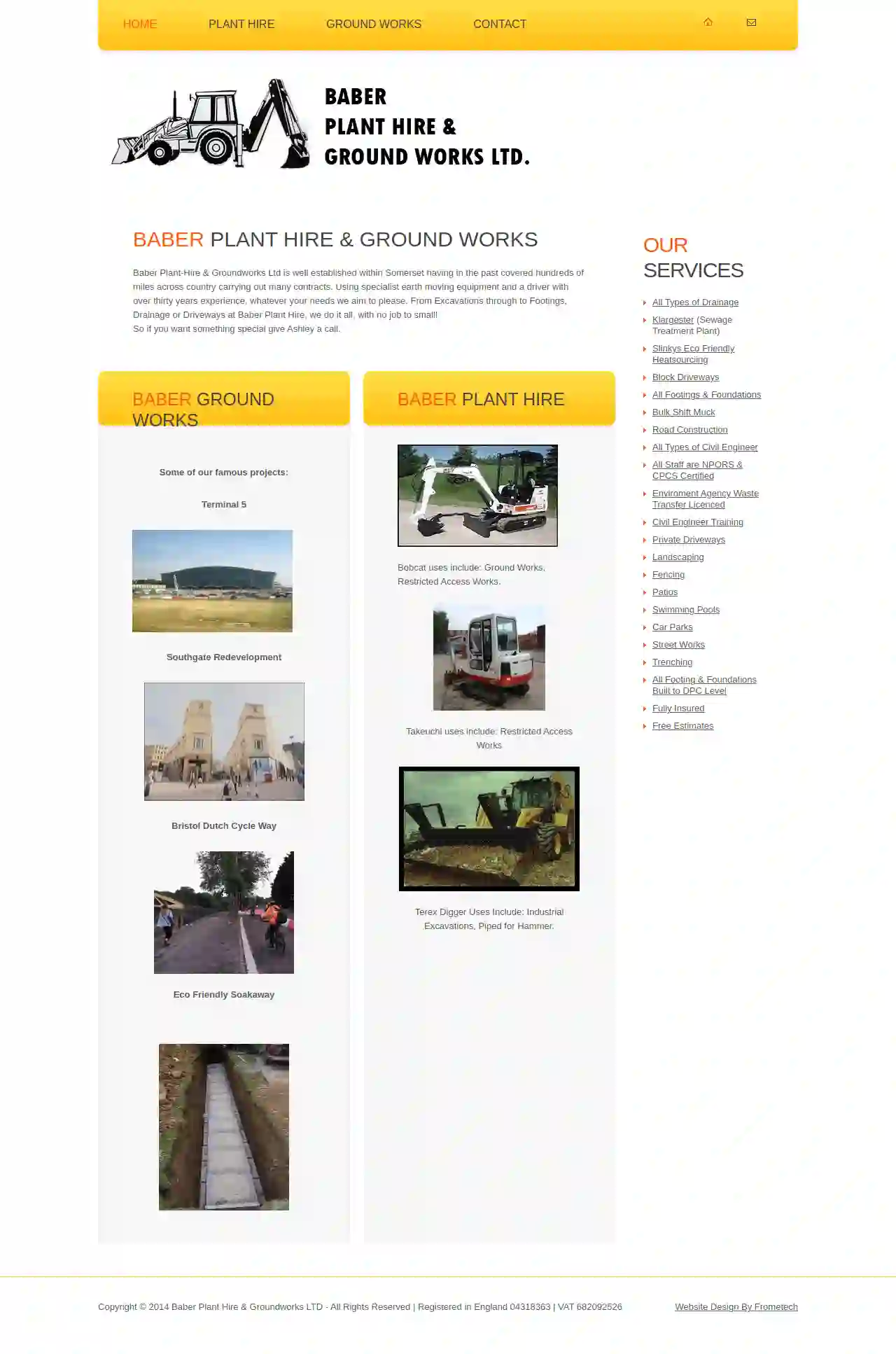
Baber Plant-Hire & Groundworks
Fern Cottage, Mount Pleasant, Culver Hill, Frome, BA11 5BA, GBBaber Plant Hire & Groundworks Ltd Baber Plant-Hire & Groundworks Ltd is a well-established company in Somerset, with a history of completing numerous contracts across the country. We utilize specialist earth-moving equipment and a driver with over 30 years of experience, ensuring we meet your needs and exceed your expectations. From excavations to footings, drainage, and driveways, Baber Plant Hire handles it all, no job is too small! If you require something special, don't hesitate to contact Ashley. Our Expertise We specialize in a wide range of services, including: • Ground Works • Restricted Access Works • Industrial Excavations • Piped for Hammer • All Types of Drainage • Klargester (Sewage Treatment Plant) • Slinkys Eco Friendly Heatsourciing • Block Driveways • All Footings & Foundations • Bulk Shift Muck • Road Construction • All Types of Civil Engineer • Private Driveways • Landscaping • Fencing • Patios • Swimming Pools • Car Parks • Street Works • Trenching • All Footing & Foundations Built to DPC Level Our Commitment We are committed to providing our clients with the highest quality service and workmanship. Our team is fully insured and NPORS & CPCS certified, ensuring your project is completed safely and efficiently. We also hold an Environment Agency Waste Transfer Licence, demonstrating our commitment to responsible waste management. Contact Us Today For a free estimate or to discuss your project, please contact us.
- Services
- Why Us?
- Gallery
Get Quote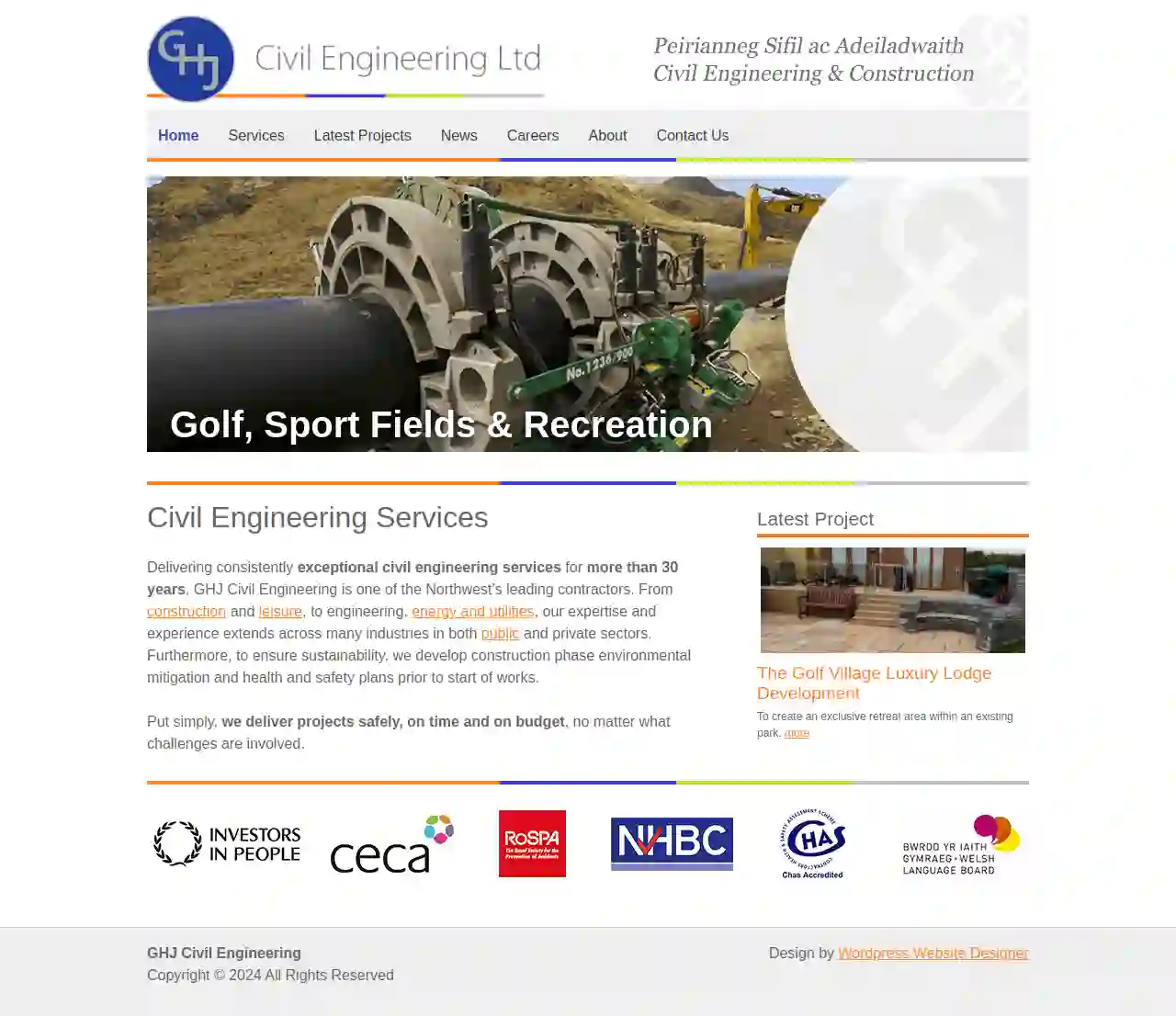
GHJ Civil Engineering Ltd
Chard, GBDelivering consistently exceptional civil engineering services for more than 30 years, GHJ Civil Engineering is one of the Northwest’s leading contractors. From construction and leisure, to engineering, energy and utilities, our expertise and experience extends across many industries in both public and private sectors. Furthermore, to ensure sustainability, we develop construction phase environmental mitigation and health and safety plans prior to start of works. Put simply, we deliver projects safely, on time and on budget, no matter what challenges are involved.
- Services
- Why Us?
- Gallery
Get Quote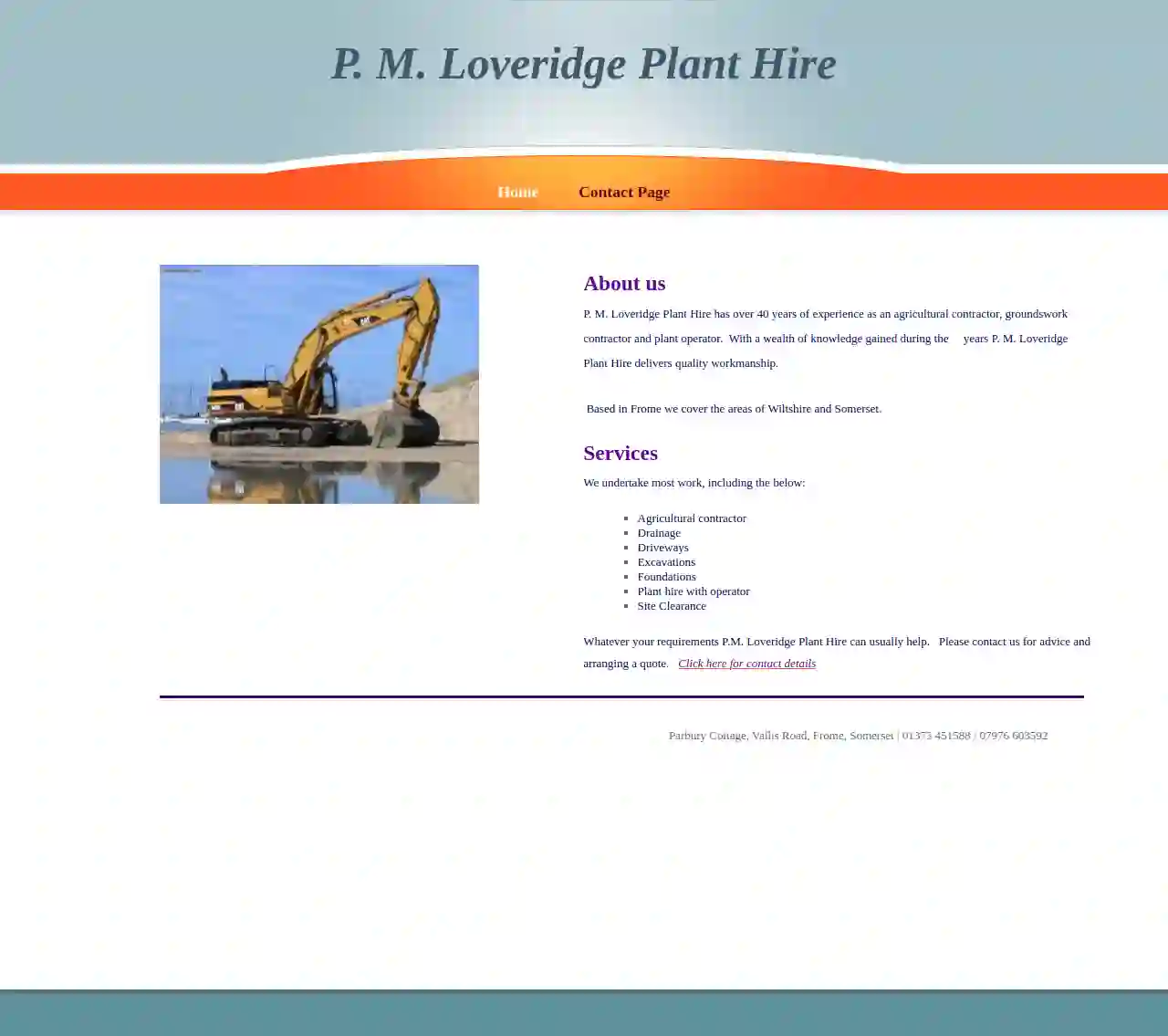
P M Loveridge Plant Hire & Groundworks
Parbury Cottage, Vallis Road, Frome, Somerset, GBAbout us P. M. Loveridge Plant Hire has over 40 years of experience as an agricultural contractor, groundswork contractor and plant operator. With a wealth of knowledge gained during the years, P. M. Loveridge Plant Hire delivers quality workmanship. Based in Frome, we cover the areas of Wiltshire and Somerset.
- Services
- Why Us?
- Gallery
Get Quote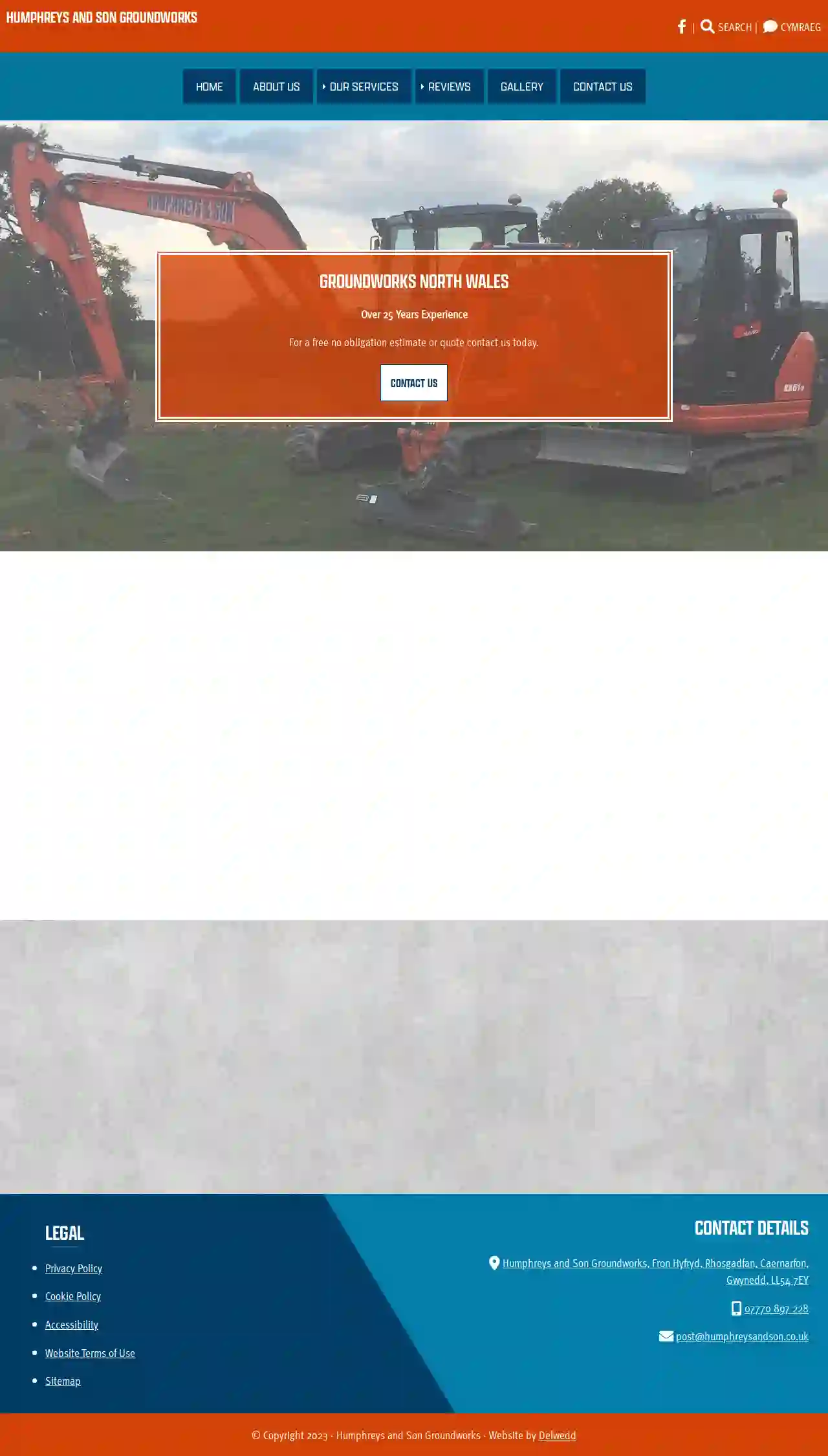
Humphreys and Son Groundworks
Fron Hyfryd, Rhosgadfan, Caernarfon, Gwynedd, LL54 7EY, GBHumphreys & Son Groundworks: Your Trusted Partner for Groundworks in North Wales Humphreys & Son Groundworks is a family-run business with over 25 years of experience, serving the North Wales region. We are dedicated to providing high-quality, reliable groundworks services, tailored to meet your specific needs. Our team of experienced professionals is committed to delivering exceptional results, ensuring your project is completed on time and within budget. We understand the importance of a strong foundation for any project, and we take pride in our meticulous approach to every job. Whether you're building a new home, extending your existing property, or undertaking a landscaping project, we have the expertise and resources to handle it all. At Humphreys & Son Groundworks, we believe in building lasting relationships with our clients. We are committed to providing clear communication, transparent pricing, and exceptional customer service throughout the entire project lifecycle. Contact us today for a free, no-obligation estimate or quote. We look forward to working with you to bring your vision to life.
- Services
- Why Us?
- Accreditations
- Gallery
Get Quote
Trueline Midlands Ltd
51 reviewsRempstone Road, Wymeswold, LE12 6UE, GBTrueline Midlands Ltd is a specialist commercial construction and land-based services contractor. Our experienced team combined with our specialist equipment means we’re tasked for any job you require. We have built our reputation based on our honest, dedicated and professional approach to our service. Our reliable, skilled team has relevant qualifications and accreditations, and is armed with the best machinery in the industry. We cover the whole of the Midlands and UK on request. Our services include groundworks, ecology, excavations, utilities, agricultural contracting, car parks, concreting, tarmac, habitat creation, fencing, drainage, and forestry, to landscaping, construction, and structural building works.
- Services
- Why Us?
- Accreditations
- Gallery
Get Quote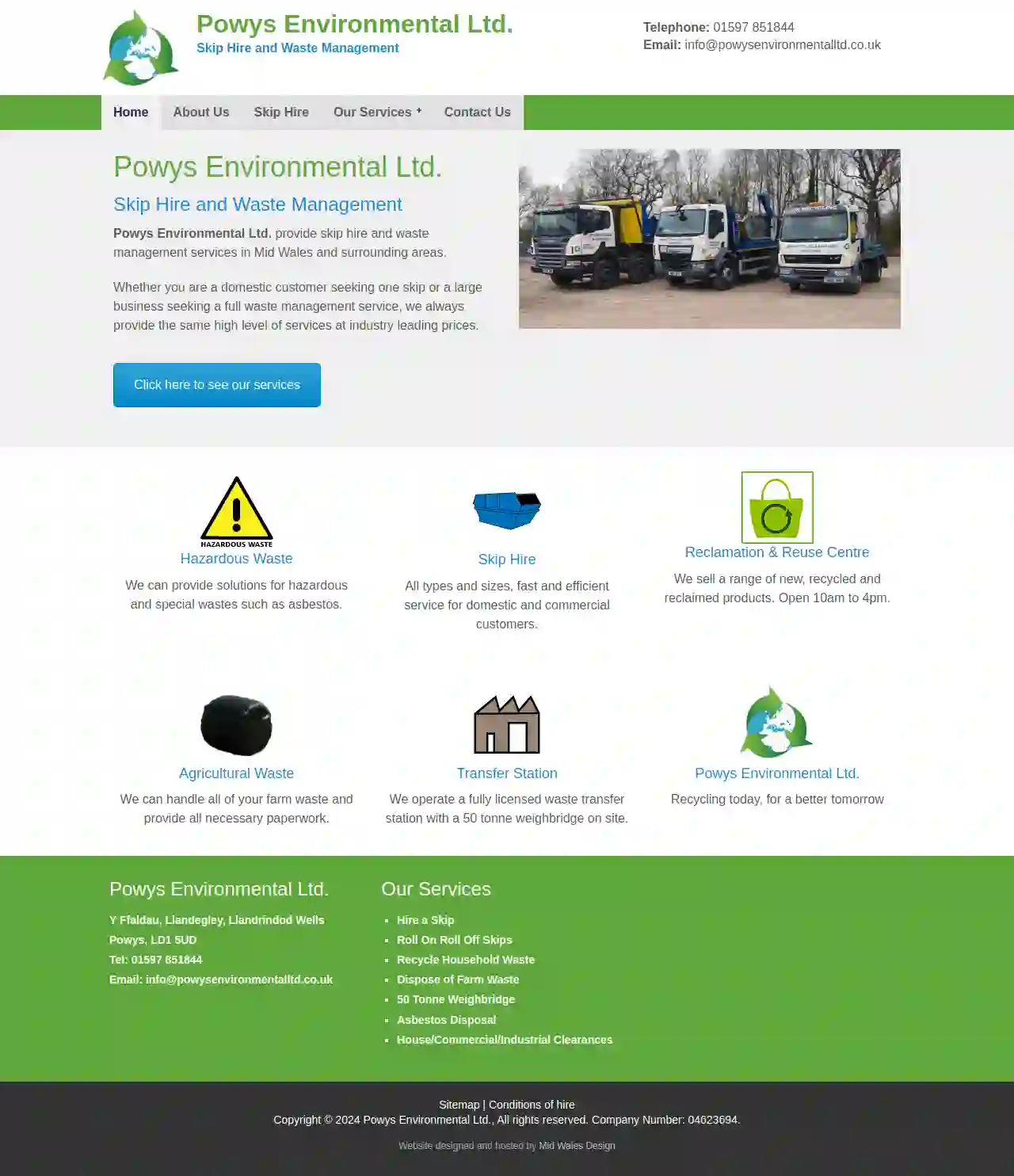
Powys Environmental Ltd
Y Ffaldau, Llandegley, Llandrindod Wells, LD1 5UD, GBPowys Environmental Ltd. - Your Trusted Waste Management Partner in Mid Wales Powys Environmental Ltd. is a leading provider of skip hire and waste management services in Mid Wales and the surrounding areas. We are committed to providing our customers with the highest quality services at competitive prices. Whether you are a homeowner needing a single skip or a large business requiring a comprehensive waste management solution, we are here to help. Our team of experienced professionals is dedicated to providing you with the best possible service. We are fully licensed and insured, and we are committed to environmentally responsible waste management practices. We are proud to be a local business, and we are committed to supporting our community. We offer a wide range of services, including: Skip hire Total waste management solutions Commercial transfer station Muck away Agricultural waste Recycled aggregates Reclamation & Reuse Centre Clearances (domestic, commercial & industrial) Hazardous waste We are committed to providing our customers with the best possible service. We are fully licensed and insured, and we are committed to environmentally responsible waste management practices. We are proud to be a local business, and we are committed to supporting our community. Contact us today to discuss your waste management needs.
- Services
- Why Us?
- Gallery
Get Quote
E A Reed & Sons Ltd Groundworks
Diamond Farm, Saughall Road, Diamond FarmSaughall RoadSaughall MassieWirral, Saughall Massie, CH46 5ND, GBEA REED & SONS At EA Reed & Sons we pride ourselves on providing our customers with the best possible solution, delivered to the highest standard. We have the skills, knowledge, and machinery to deliver your project cost effectively to meet your timeframe. We work with a wide range of clients, from home owners right through to first tier contractors. We also have extensive knowledge of the needs of agricultural customers. The following are a small collection of the services that we can provide: Plant hire with driver/operator Civils/Groundwork Resurfacing Clearance & Demolition Industrial Fencing How can we help? Whatever your project, however large or small, we are here to help. For your free quotation or for any advice contact us on 07912 293 838 or 07774 608 674, and one of our team will be able to assist you. Alternatively, drop us an email on [email protected], and someone will contact you as soon as possible.
- Services
- Why Us?
- Our Team
- Testimonials
- Gallery
Get Quote
Over 13,059+ Excavation Contractors registered
Our excavation companies operate in Langport & surrounding areas!
ExcavationHQ has curated and vetted the Best Excavation Contractors in Langport. Find a top & reliable pro today.
Frequently Asked Questions About Excavation Contractors
- Planning and Surveying: Defining the excavation area, marking utility lines, and determining the required depth and grade.
- Site Preparation: Clearing vegetation, removing obstacles, and ensuring site accessibility.
- Excavation: Using appropriate equipment (excavators, backhoes, etc.) to remove earth and create the desired excavation.
- Hauling and Disposal: Transporting excavated material to designated disposal sites, complying with environmental regulations.
- Backfilling and Compaction: Refilling the excavation with suitable material and compacting it to achieve the required density and stability.
- Grading and Finishing: Leveling and shaping the surface to the final grade for landscaping or construction.
- Clearly Define the Scope: Outline the project's goals, including the excavation area, depth, grade, and intended use.
- Obtain Necessary Permits: Research and acquire any required permits from your local authorities.
- Mark Utility Lines: Contact your utility companies to locate and mark underground utilities to prevent damage.
- Communicate with Neighbors: Inform your neighbors about the project's timeline and potential noise or disruptions.
- Prepare the Site: Clear any obstacles, such as vegetation, furniture, or structures, from the excavation area.
- Discuss Safety Protocols: Review safety procedures with the contractor to ensure a safe work environment.
- Trench Collapses: Unstable trench walls can cave in, posing a severe risk to workers. Proper shoring and sloping are crucial safety measures.
- Utility Damage: Striking underground utilities (gas, water, electric) can cause leaks, explosions, or electrocution. Accurate utility locates and careful digging are essential.
- Falling Objects: Materials or equipment falling into excavations can injure workers. Securing work areas and using appropriate safety gear is vital.
- Equipment Accidents: Operating heavy machinery involves risks of rollovers, collisions, or mechanical failures. Trained operators and proper equipment maintenance are critical.
- Environmental Hazards: Excavated soil might contain hazardous materials (asbestos, lead). Proper testing and disposal procedures are necessary.
- Basement Size: The larger the basement, the more excavation is required, increasing the cost.
- Soil Type: Excavating rocky or dense clay soil is generally more expensive than loose soil.
- Accessibility: Difficult-to-access sites might require specialized equipment or more labor, driving up costs.
- Foundation Type: The chosen foundation type (full basement, crawl space, slab) affects excavation needs.
- Underpinning: If underpinning (strengthening existing foundations) is necessary, it significantly increases costs.
- Disposal Fees: Hauling excavated soil to disposal sites adds to the overall expense.
What is the excavation process?
What should I do before excavation starts?
What are the risks associated with excavation?
How much does it cost to excavate a basement?
What is the excavation process?
- Planning and Surveying: Defining the excavation area, marking utility lines, and determining the required depth and grade.
- Site Preparation: Clearing vegetation, removing obstacles, and ensuring site accessibility.
- Excavation: Using appropriate equipment (excavators, backhoes, etc.) to remove earth and create the desired excavation.
- Hauling and Disposal: Transporting excavated material to designated disposal sites, complying with environmental regulations.
- Backfilling and Compaction: Refilling the excavation with suitable material and compacting it to achieve the required density and stability.
- Grading and Finishing: Leveling and shaping the surface to the final grade for landscaping or construction.
What should I do before excavation starts?
- Clearly Define the Scope: Outline the project's goals, including the excavation area, depth, grade, and intended use.
- Obtain Necessary Permits: Research and acquire any required permits from your local authorities.
- Mark Utility Lines: Contact your utility companies to locate and mark underground utilities to prevent damage.
- Communicate with Neighbors: Inform your neighbors about the project's timeline and potential noise or disruptions.
- Prepare the Site: Clear any obstacles, such as vegetation, furniture, or structures, from the excavation area.
- Discuss Safety Protocols: Review safety procedures with the contractor to ensure a safe work environment.
What are the risks associated with excavation?
- Trench Collapses: Unstable trench walls can cave in, posing a severe risk to workers. Proper shoring and sloping are crucial safety measures.
- Utility Damage: Striking underground utilities (gas, water, electric) can cause leaks, explosions, or electrocution. Accurate utility locates and careful digging are essential.
- Falling Objects: Materials or equipment falling into excavations can injure workers. Securing work areas and using appropriate safety gear is vital.
- Equipment Accidents: Operating heavy machinery involves risks of rollovers, collisions, or mechanical failures. Trained operators and proper equipment maintenance are critical.
- Environmental Hazards: Excavated soil might contain hazardous materials (asbestos, lead). Proper testing and disposal procedures are necessary.
How much does it cost to excavate a basement?
- Basement Size: The larger the basement, the more excavation is required, increasing the cost.
- Soil Type: Excavating rocky or dense clay soil is generally more expensive than loose soil.
- Accessibility: Difficult-to-access sites might require specialized equipment or more labor, driving up costs.
- Foundation Type: The chosen foundation type (full basement, crawl space, slab) affects excavation needs.
- Underpinning: If underpinning (strengthening existing foundations) is necessary, it significantly increases costs.
- Disposal Fees: Hauling excavated soil to disposal sites adds to the overall expense.